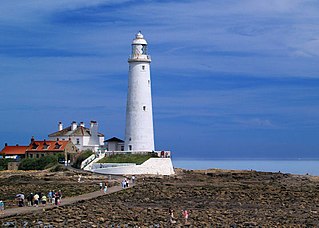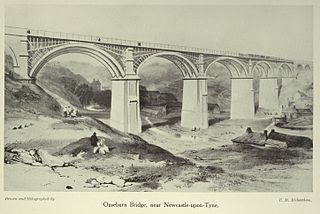Related Research Articles

Wallsend is a town in North Tyneside, Tyne and Wear, England, at the eastern end of Hadrian's Wall. It has a population of 43,842 and lies 4 miles east of Newcastle upon Tyne.

North Tyneside is a metropolitan borough in the metropolitan county of Tyne and Wear, England. It forms part of the greater Tyneside conurbation. North Tyneside Council is headquartered at Cobalt Park, Wallsend.

Percy Main is a Tyne and Wear Metro station, serving the suburb of Percy Main, North Tyneside in Tyne and Wear, England. It joined the network on 14 November 1982, following the opening of the fourth phase of the network, between Tynemouth and St James via Wallsend.

Howdon is a Tyne and Wear Metro station, serving the suburb of Howdon, North Tyneside in Tyne and Wear, England. It joined the network on 14 November 1982, following the opening of the fourth phase of the network, between Tynemouth and St James via Wallsend.

The Tyneside Electrics were the suburban railways on Tyneside that the North Eastern Railway and the London and North Eastern Railway electrified using the third rail system. The North Tyneside Loop was electrified from 1904 onwards and formed one of the earliest suburban electric networks; the South Tyneside line to South Shields via Pelaw was electrified in March 1938. British Railways converted these lines to diesel operation in the 1960s: the line to South Shields in January 1963 and the North Tyneside lines in June 1967 when the electrical supply infrastructure and the rolling stock had become life expired. In addition, the system was losing passengers and suffering from costly vandalism. Since the late 1970s, much of the system has been converted to form the Tyne and Wear Metro.
The North Tyneside Loop refers to the railway lines in North Tyneside from Newcastle upon Tyne via Wallsend, North Shields, Whitley Bay, Backworth, Benton and South Gosforth back to Newcastle. Since the 1980s, it has formed part of the Tyne and Wear Metro, albeit in modified form.

The Newcastle and North Shields Railway opened in June 1839 from a temporary terminus in Carliol Square in Newcastle upon Tyne to North Shields. The railway was absorbed by the Newcastle & Berwick Railway in November 1844. The Newcastle & Berwick Railway was itself absorbed by the York, Newcastle and Berwick Railway, and this became part of the North Eastern Railway in 1854.
The Blyth and Tyne Railway was a railway company in Northumberland, England, incorporated by Act of Parliament on 30 June 1852. It was created to unify the various private railways and waggonways built to carry coal from the Northumberland coalfield to Blyth and the River Tyne, which it took control of on 1 January 1853. Over time, the railway expanded its network to reach Morpeth (1857/8), North Seaton (1859), Tynemouth (1860/1), Newcastle upon Tyne (1864), and finally Newbiggin-by-the-Sea (1872). It became part of the much larger North Eastern Railway in 1874.

Howdon is a largely residential area in the eastern part of Wallsend, Tyne and Wear, England. It consists of High Howdon and the smaller settlement of East Howdon. Much of the High Howdon area was formerly called Willington prior to post-World War II urbanisation. The North Tyneside ward population at the 2011 Census was 11,129.

Jarrow is a Tyne and Wear Metro station, serving the town of Jarrow, South Tyneside in Tyne and Wear, England. It joined the network on 24 March 1984, following the opening of the fifth phase of the network, between Heworth and South Shields.

Willington Quay is an area in the borough of North Tyneside in Tyne and Wear in northern England. It is on the north bank of the River Tyne, facing Jarrow, and between Wallsend and North Shields. It is served by the Howdon Metro station in Howdon. The area from 2006 onwards has been an area of new housing built on brownfield sites. The house building continues into 2013 and is changing the social and economic balance in the area. The area has also had a make over of the bowling green off Howdon Lane and further warehousing next to the bowling green has been demolished to make way for further new housing. The changes made recently at Willington Quay are now making it an attractive place to live within North Tyneside.

Hebburn is a Tyne and Wear Metro station, serving the town of Hebburn, South Tyneside in Tyne and Wear, England. It joined the network on 24 March 1984, following the opening of the fifth phase of the network, between Heworth and South Shields.

Tynemouth is a Tyne and Wear Metro station, serving the coastal town of Tynemouth, North Tyneside in Tyne and Wear, England. It joined the network as a terminus station on 11 August 1980, following the opening of the first phase of the network, between Haymarket and Tynemouth via Four Lane Ends.
The Riverside Branch was a 6+1⁄2-mile (10.5 km) double-track branch line, which ran between Riverside Junction in Heaton and Percy Main West Junction in Percy Main.
Walker was a railway station on the Riverside Branch which ran between Byker and Willington Quay. The station served Walker in Newcastle upon Tyne.

Byker was a railway station on the Riverside Branch, which ran between Byker and Willington Quay. The station served Byker in Newcastle upon Tyne.
Willington Quay was a railway station on the Riverside Branch, which ran between Byker and Willington Quay. The station served Willington Quay in North Tyneside.

Carville was a railway station on the Riverside Branch, which ran between Byker and Willington Quay. The station served Wallsend in North Tyneside.
St. Anthonys was a railway station on the Riverside Branch, which ran between Byker and Willington Quay. The station served Walker in Newcastle upon Tyne.
St. Peters was a railway station on the Riverside Branch, which ran between Newcastle and Willington Quay.
References
- 1 2 Quick, Michael (2009). Railway Passenger Stations in Great Britain: A Chronology. Railway and Canal Historical Society. p. 325. ISBN 978-0901461575.
- ↑ Allen, Cecil J. (1974). The North Eastern Railway. London: Allan. pp. 81 and 82. ISBN 0-7110-0495-1. OCLC 1255585.
- ↑ Tomlinson, William Weaver (1914). The North Eastern Railway: Its Rise and Development. Newton Abbot: David and Charles.
- ↑ Allen, Cecil J. (1974). The North Eastern Railway. London: Allan. p. 115. ISBN 0-7110-0495-1. OCLC 1255585.
- ↑ Young, Alan (1999). Suburban Railways of Tyneside. ISBN 1-871944-20-1.
- ↑ Hoole, Kenneth (1974). A Regional History of the Railways of Great Britain: Volume IV, The North East. Newton Abbot: David and Charles. p. 204. ISBN 0-7153-6439-1. OCLC 643508708.
- ↑ Young, Alan (1999). Suburban Railways of Tyneside. ISBN 1-871944-20-1.